My family loves this easy green cabbage kimchi recipe. It’s spicy and crunchy and salty. This fermented kimchi is a great side dish for those nights you don’t have time to make a salad, so having a jar of this fermented goodness in the fridge is a timesaver for busy nights!
New to fermenting foods? Be sure to read this compilation of frequently asked questions before you get started!
Love fermenting? Check out these 50+ recipes for fermented foods.
Naturally fermented kimchi is full of friendly bacteria and enzymes. And it’s easy to make!
First, What IS Kimchi?
Kimchi is fermented cabbage, served as a side dish. It’s a staple in Korean cuisine. It’s made with green cabbage (Napa cabbage is common) as the base, seasoned with chilis, garlic, ginger, and scallions, and salted for preservation.
Kimchi was not prominent in my life before moving to Hawai‘i but it’s abundant here and I love it. Of course, I had to figure out how to make it myself so I could enjoy it whenever I want!
I’ve learned to make it this way over the years. But I am not Korean and I wouldn’t consider this to be a traditional Korean kimchi recipe. I considered calling it fermented cabbage, but that’s sauerkraut, right? This easy kimchi recipe is a much spicier alternative!
5 Easy Steps to Transform Your Pantry!
Ready to switch from store bought to homemade? Let me help you make some changes! Grab my FREE five-part guide to getting started.
Ingredients
Napa cabbage — This green cabbage is more “ruffly” than head cabbage and is what is commonly used to make kimchi.
Bok choy — This dark green veggie adds variety and a different texture to the mixture. If you’d prefer, you can substitute the bok choy with more green cabbage.
Carrots — Slice fresh carrots into a thin julienne, or matchsticks. You could also coarsely shred them.
Daikon radish — This large, white radish is commonly used in Asian cuisine. The flavor is milder than common radish.
Aromatics — This recipe uses both garlic and green onions. Finely chopped garlic adds that spicy zing we all love so much.
Ginger — Use fresh ginger, not powdered, for its spicy and robust flavor.
Salt — I use Hawaiian alaea salt, but you can use any non-iodized salt, such as sea salt or Himalayan salt.
Chili flakes — This is what brings the heat to the kimchi! If you like less spice, you can certainly reduce the amount called for in the recipe. Traditional kimchi recipes call for Korean chili flakes, aka gochugaru, but if you don’t have access to those, more common red chili pepper will work fine.
Note: Some people use a prepared kimchi paste that is available on the island. I like the flavor of it, but I don’t like that it has MSG, so I don’t use it. Instead I use fresh ginger, garlic, and red pepper flakes to season this ferment.
Making Kimchi
Kimchi requires a lot of chopping and some patience. Some kimchi has quite large chunks of vegetables; I prefer mine a bit smaller. Chop the veggies for this easy kimchi recipe according to your preferences. If you like yours really fine, you can use a food processor to do the work of slicing the vegetables.
The Fermentation Process
Transfer the mixture to a half gallon jar or two quart jars, pushing the fresh produce down until it’s completely covered by the juices. It’s critical that the solids remain under the liquid.
Leave the jar(s) out at room temperature, checking the liquid level daily. The veggies need to remain completely submerged. Mix two teaspoons of salt into a cup of filtered water and use that salt water to top off the kimchi ferment if necessary.
As days pass, the kimchi will take on a slightly pickled odor, which is exactly what you want! You may see bubbles in the mixture as it ferments, but that’s not always true. Bubbling is fine, and just gives you a visual that the mixture is fermenting.
It’s a good idea to set the jar of kimchi on a tray to capture any potential overflow.
Storage
Once the kimchi is fermented, place the jars in the refrigerator or in a cool place, such as a basement or root cellar.
Using Kimchi
I use kimchi as a simple side dish, but it’s commonly used to make kimchi fried rice. You can stir the veggies into an assortment of meals, but heating the kimchi will kill off the probiotics.
FAQs
Is kimchi vegan?
This is a fermented vegetable dish — why wouldn’t it be vegan?? Well, some kimchi recipes call for shrimp or fish sauce. I wasn’t trying to create a vegan kimchi recipe, but since we don’t use those fishy ingredients in this recipe, it turns out it is!
How long does kimchi take to ferment?
This kimchi takes several days, or as long as a week to fully ferment. This will depend on the temperature in your kitchen. Warmer days are conducive to faster fermentation.
How do you know if kimchi is fermented enough?
First, it’s totally fine to eat the kimchi fresh, before it’s completely fermented. But for the best flavor and probiotics, you’ll want it to ferment. It should take on a slight vinegar-y odor. The finished kimchi should taste delicious to you. If you prefer a more tangy kimchi, leave it on the counter for another day or two.
Consider picking up a pack of pH paper to test your products for acidity level when fermenting. A safe ferment will have a reading of 4.6 or lower.
★ Did you make this easy kimchi recipe? Don’t forget to give it a star rating below! ★
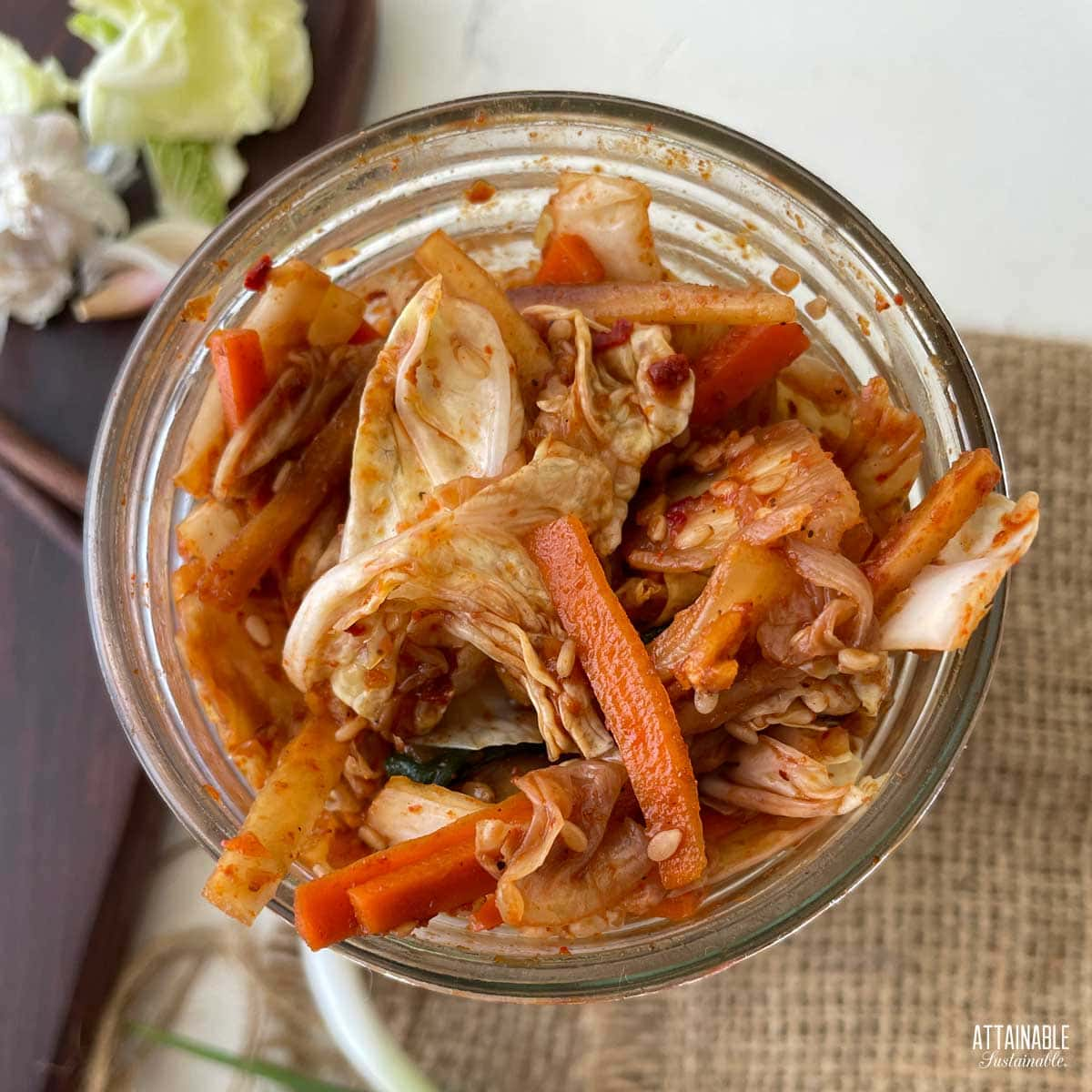
Green Cabbage Kimchi Recipe
Ingredients
- 1 head green cabbage
- 3 small bunches bok choy
- 3 green onions sliced
- 1 cup daikon julienned or shredded
- 1 cup carrots julienned or shredded
- 1 ½ tablespoons salt non-iodized
- 8 - 10 cloves garlic
- 1 inch fresh ginger
- 1 - 3 tablespoons red pepper flakes
- 1 tablespoon sesame seeds optional
Instructions
Prepare the kimchi
- Reserve one outer leaf of cabbage. Chop the remaining cabbage, bok choy, and green onions coarsely and put in large bowl. Mix in daikon, carrot, and salt. Work the ingredients with your hands. This step helps the cabbage release its juices. The bulk of the greens will reduce by about half as you work it.1 head green cabbage, 3 small bunches bok choy, 3 green onions, 1 cup daikon, 1 cup carrots, 1 1/2 tablespoons salt
- Set greens aside; mince the garlic and ginger and stir into the cabbage along with the pepper flakes and sesame seeds.8 - 10 cloves garlic, 1 inch fresh ginger, 1 - 3 tablespoons red pepper flakes, 1 tablespoon sesame seeds
- Transfer mixture to a half gallon jar (or two quart jars). Push the greens down until they’re covered by juices.
- Place the retained cabbage leaf over the top of the kimchi to help keep the small bits under liquid. Place one or two glass weights on top of cabbage. If the solid ingredients are not entirely covered by juices, top it off with a bit of filtered water. It’s essential that the ingredients for this kimchi recipe are completely submerged.
Fermenting the kimchi recipe
- Let sit at room temperature for a several days or a week, then refrigerate or store in a cool, dry place.
Notes
- It will not look like you have much juice, initially. When you press the ingredients for this kimchi recipe down into the jar, you’ll be surprised.
- 2 tablespoons of red pepper flakes makes a fairly spicy kimchi; 3 makes it fiery. Use more or less to taste.

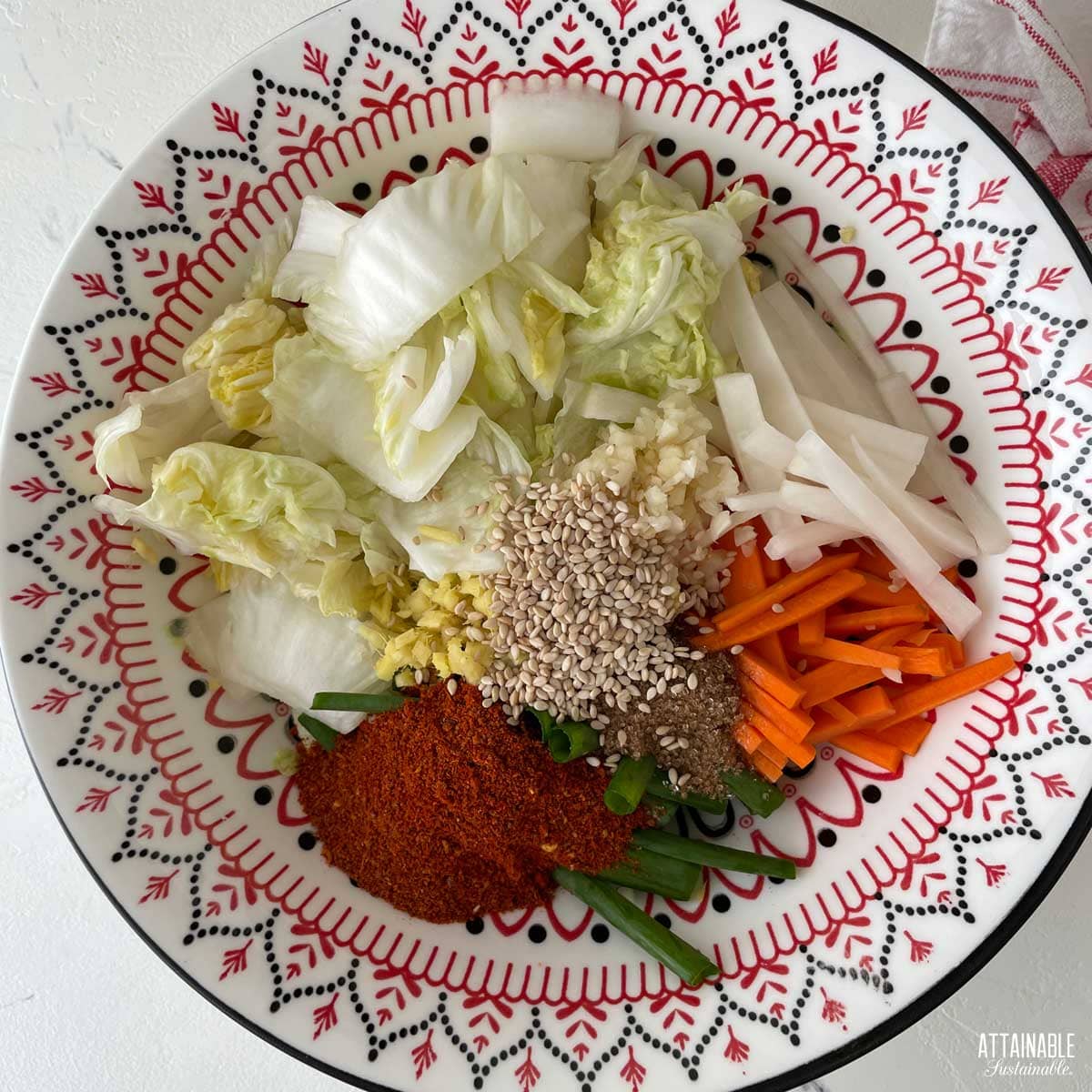
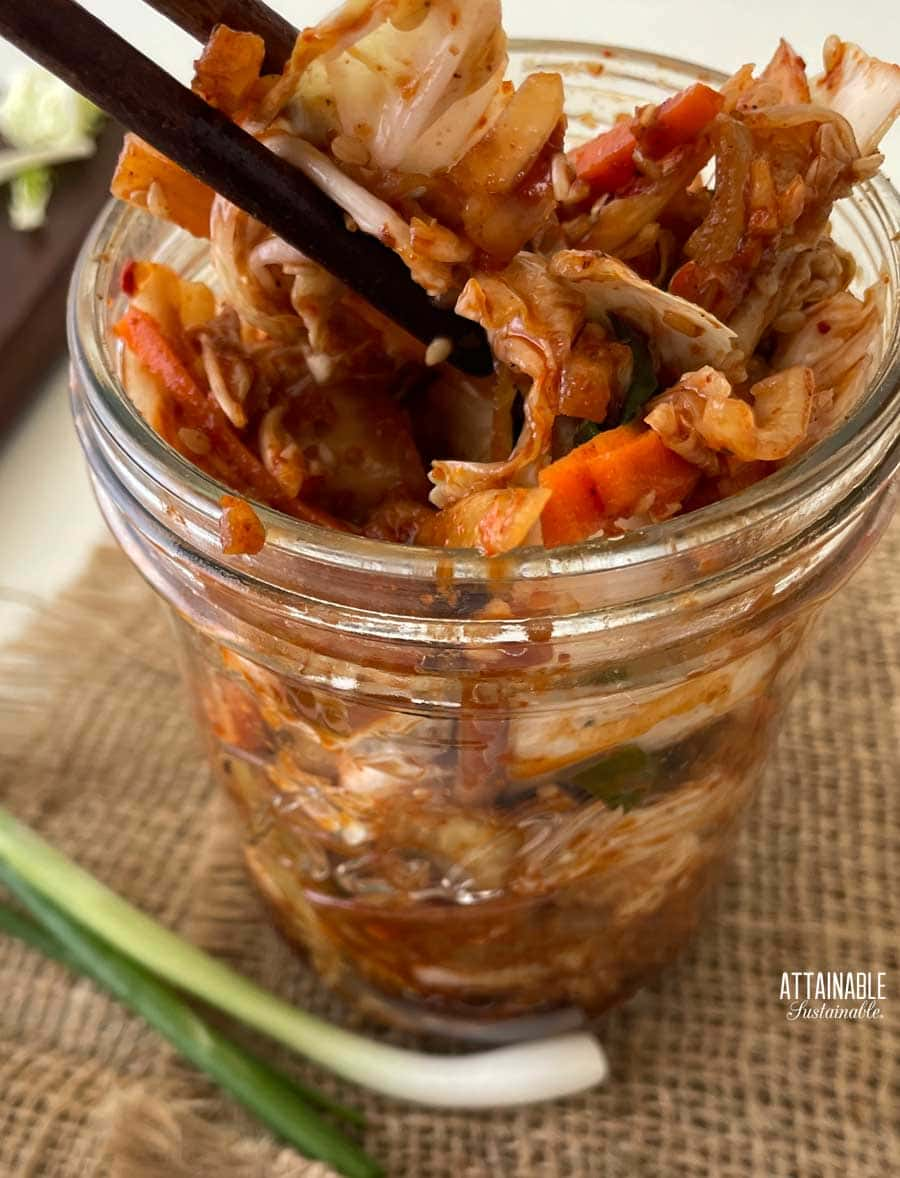
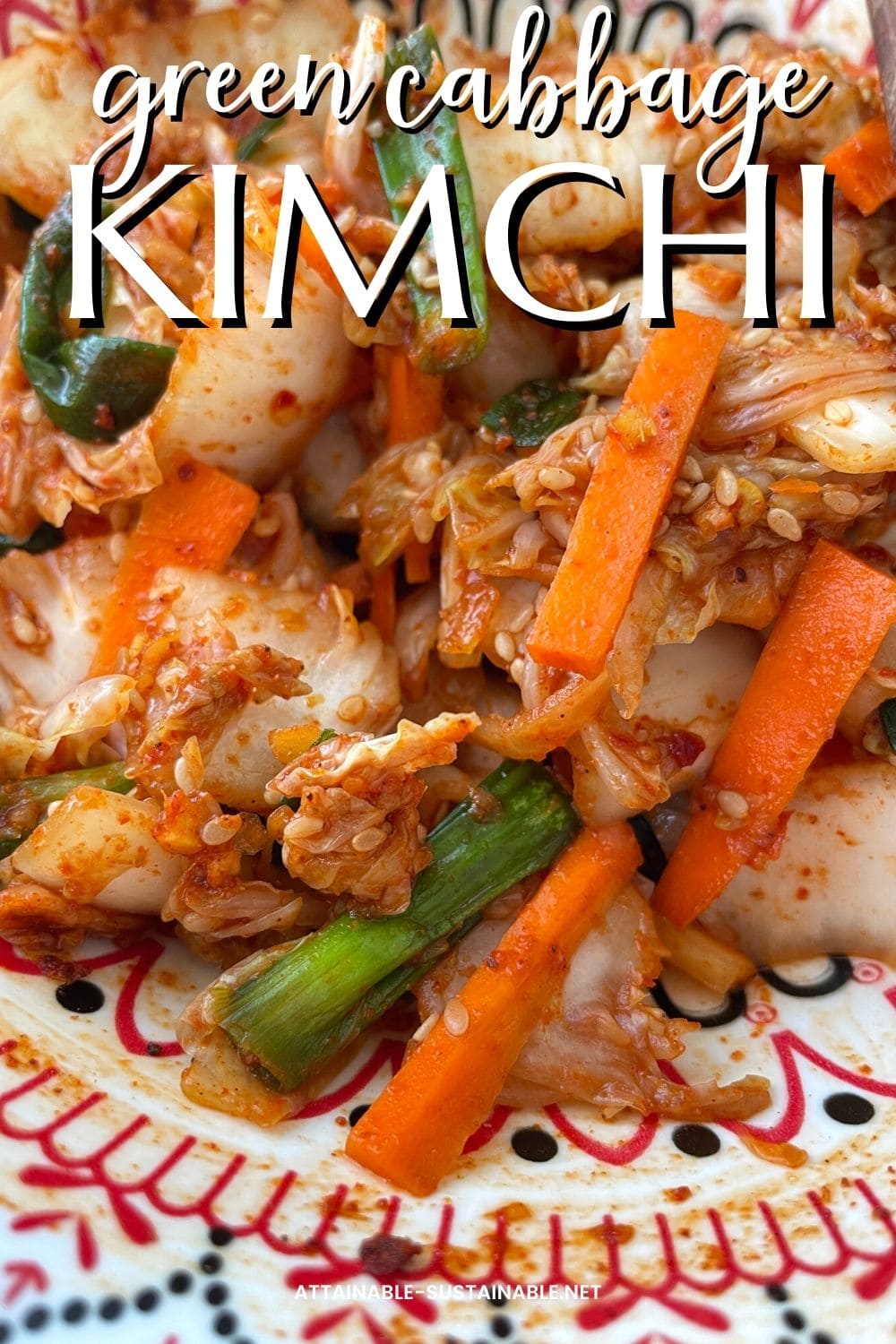

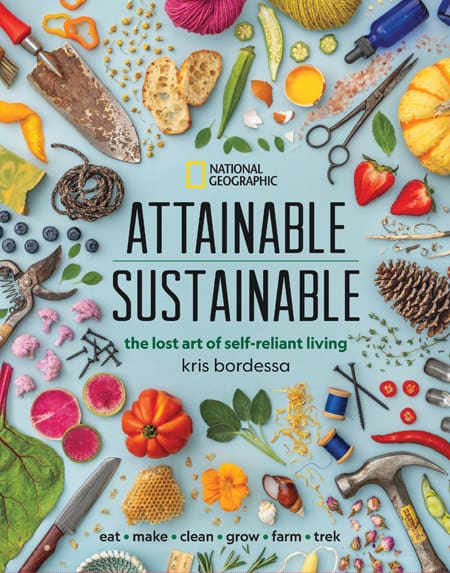
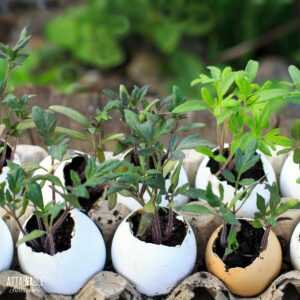
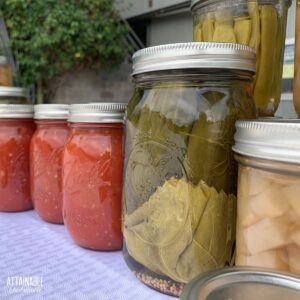

I’ve never even tasted Kimchi but heard about all the healthy gut benefits. This recipe looked easy so I took a chance and made it with only 1/2 Tbs of red pepper flakes. It is so good! I only had a quart mason jar so made it in a glass gallon ice tea dispenser and filled my quart mason jar with water to use as a weight. Worked perfectly. Bought a 2.5 quart mason jar which I’ll use next time. Thanks for posting this recipe!
Another kimchi convert! 😉
Once you pack up the jar pressing down on the ingredients, do you put the lid on the jar before setting it aside to ferment and release the gas now and then? You mentioned having the Kimchee jar on a saucer/ plate to catch the overflow of juices – tells me the kimchee jar doesn’t need to have its lid on when fermenting. Am I reading it corfectly?
I usually use a towel to cover it or a lid with an airlock, that way you don’t have to release the gasses.
Could I make without bok choy? I have everything else in my garden.
Yes, you can replace the bok choy with another green. (If you just skip it, the result will be saltier.)
Hi! SOS, just made this and am new to fermenting. Stupid question, I had to improvise for weights inside jar that extend past top of jar…is the jar supposed to be sealed while sitting out?
Sorry, just getting to this! I hope it came out okay. You need to prevent bugs from getting in. Sealing a jar with a lid is okay IF you open it every day to release built up gasses.
My problem is the glass weights: they always fall to the side and slip to the bottom, leaving the blend uncovered by the liquid!!! This has happened every time I try fermenting kraut, or other fermented things. How do you keep the glass weights on TOP????
I didn’t have glass weight so I felled a small jar with wayer and put on top it seems to be working!
That works!
Kimchi is Korean. (Japanese people can enjoy it as an imported food of course, which they enjoy and call Kimuchi.)
Yes, which I’ve stated a number of times in the article itself. The little recipe card form I use doesn’t offer Korean as an option, though. 🙁
Sounds so good…
can you store this in your pantry like you can kraut? or do you need to do something different? I have started fermenting a few things ,so I need to know because I will not have enough refrigerator space .
You can store it in a *cool place, much like you would kraut.
We made sour kraut for the first time a few weeks ago and it turned out awesome! We are currently stationed in Korea so off to the market I go to get the bounty to make, I plan to stop by and pick up a kimchi pot while we are at it… technique to ferment will be slightly different but hopefully the result will be the same! #excitedaboutkimchi
It’s on my long term to do list — to make kim chee. Thanks for this recipe. I am eager to try it. (I’ve been saying that for awhile but I AM going to do it one of these days…)
That sounds yummy… : )
This is a much easier version than others I’ve seen…Mahalo, Kris!